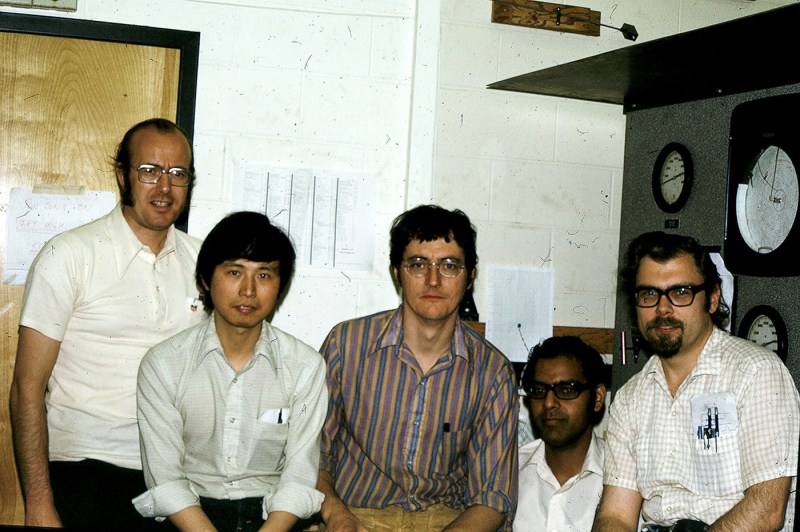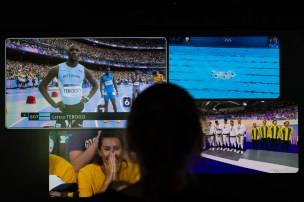Published on
The untold story of how two Northeastern professors analyzed moon rocks for NASA a half-century ago
The lunar samples were the most precious materials on Earth following the 1969 Apollo moon landing. Robert Lowndes, whose career at Northeastern spanned 46 years, explains how they came — amid secrecy — to the university.

The rocks were billions of years old. But they were new to the Earth. They were sent by NASA in 1972 via special delivery to Robert Lowndes and Clive Perry, physics professors at Northeastern University, who opened the boxes in their secured labs in the basement of Dana Hall.
“It was very exciting,” Lowndes says.
The rocks and the accompanying soil samples had been collected from the moon by the Apollo astronauts. Lowndes and Perry were among the small, initial group of U.S. professors selected by NASA to perform experiments on the moon rocks.
The first shipment arrived two years after astronauts Neil Armstrong and Edwin “Buzz” Aldrin became the first human beings to land on the moon.
“The rocks were quite small, an inch or so is what I remember,” Lowndes says. “And then we also got the soil samples, which were powders.”
The Northeastern physicists would receive multiple shipments of lunar samples that had been retrieved by the astronauts of Apollo missions 11, 12, 14 and 15 from 1969 to 1971. The rocks and powders were arguably the most precious materials in the world at that time — more valuable and rare than any earthbound piece of jewelry or source of energy.
The pricelessness of the samples was conveyed to the Northeastern professors by NASA.
“NASA wanted a total assurance that they would be safe,” Lowndes says of the moon rocks. “And so one of the conditions was that only Clive and myself could have a key to the labs. NASA stressed that they didn’t want the campus police to have a key or even the president of the university, who at that time was Asa Knowles. So we had to clear this with everybody inside the university because that’s the way it was.”

The other aspect was secrecy. Very few people knew that Northeastern had possession of the moon rocks, much less that two of its professors were analyzing them.
Lowndes was reminded of NASA’s emphasis on security when he told the story of his and Perry’s moon rock experiments at a recent breakfast honoring more than 200 people who had worked at Northeastern for 25 years or more. He was surprised to realize that the event had not become part of the university’s folklore.
“They didn’t know or didn’t remember anything about the moon rocks,” Lowndes says. “Some of them were at Northeastern at that time. But nobody recollected this had happened.”
‘An entrepreneurial thing’
Lowndes, born and raised in the U.K., moved to Boston in 1967. One year later he became a professor at Northeastern, not long before the historic moon land of Apollo 11.
An estimated 650 million people around the world watched on July 20, 1969, as Armstrong hopped off a ladder and onto the powdery surface while declaring, “That’s one small step for a man, one giant leap for mankind.”
It fulfilled the 1961 vision of President John F. Kennedy, who had famously challenged the U.S. to land a man on the moon before the end of the decade as part of his country’s Cold War space race against the Soviet Union.
“I was on a beach in Rhode Island when the news came out that they had landed,” Lowndes says. “It was a year or so later that we got the [NASA] grants, which meant that we were actually going to be working with the moon rocks that had come from their landing.”


Lowndes and Perry had already performed research for NASA when they applied for a grant to study the moon rocks. They did not expect to be selected.
“It was sort of an entrepreneurial thing,” Lowndes says.
The research efforts of Lowndes and Perry were focused on using far infrared and laser Raman spectroscopy to examine the moon rocks and discover their properties.
Both physicists had graduated from Queen Mary College, University of London, where state-of-the-art far infrared spectroscopic techniques had been developed. Perry and Lowndes were considered leaders in the field.
They realized the exclusivity of their engagement when they were invited to the Manned Spacecraft Center (known today as the Lyndon B. Johnson Space Center) in Houston. They were introduced to astronauts Aldrin and Jim Lovell, who in 1970 had piloted Apollo 13 home after a critical failure to its oxygen system (he would be portrayed by Tom Hanks in the 1995 movie “Apollo 13”).

Lowndes recalls meeting professors from fewer than 10 universities who had also been engaged by NASA to study the moon samples.
“At the first meeting we were being briefed by Buzz Aldrin, who was using a laser pointer to show us where the next Apollo mission was planning to land,” Lowndes says. “He was sitting 30 or 40 feet back of the screen and when he switched the laser pointer on, he didn’t have to move the pointer around. It was pointed right at the planned landing area.”
It was a small event that revealed the astronaut’s unusual steadiness and hand-eye coordination.
“I don’t know if you’ve ever used a laser pointer, but they tend to [flit] around,” Lowndes says. “Here he was just holding it in his hand. His hand wasn’t resting on anything and yet the laser point wasn’t moving at all. I thought that was amazing.”
Similarities to Earth
In all, NASA would collect 842 pounds of lunar material — 2,200 samples — retrieved during six Apollo missions.
The earliest samples were the stuff of mystery and concern. An elaborate $7.8 million Lunar Receiving Laboratory was built in Houston to protect Earth from the potential threat of alien microorganisms. According to a NASA account:
Scientists and technicians entering the laboratory had to strip off their clothes and put on lab clothing. Persons leaving had to strip off the lab clothes, shower, walk nude through a lock bathed in ultraviolet (UV) light and then they could put on their street clothes. Not many of the planetary scientists, astronauts or technicians took the quarantine seriously, figuring that the Moon already had a sterilization system of its own which included irradiation with UV.
When the rocks arrived, the sealed boxes were placed into the vacuum system known as the F-201. A technician working in spacesuit vacuum gloves manipulated the samples … the quarantine people fed lunar fines to mice, quail and other life forms, watching for signs of ill effects and marveling that plants grew better in lunar soil than quartz sand. Planetary scientists were unhappy about the amount of material which they viewed as wasted on these experiments and the extent to which quarantine diminished the focus on planetary research.
There would be no cases of contamination from the moon samples, which have yielded no chemical evidence of life in any form.
Rather than posing a risk, the rocks and powders have spawned the new field of lunar science.
Many of the moon rocks were found to contain glass, which was formed by the high pressures and temperatures resulting from meteorites striking the moon. The glass has survived for billions of years because of the absence of water on the moon — which in itself was another surprise for scientists.
Lowndes recalls that the rocks were black and sooty, which was striking. At night the moon appears to be pale white, due to its contrast with the nonreflective surroundings of space. In fact the surface of the moon is quite dark.
The rocks and powders arrived in multiple shipments. Lowndes and Perry warned NASA that they would need to manipulate the samples in order to perform their experiments.
“We had indicated to them that in some of the spectroscopic studies, we would have to polish one surface of a rock a little bit,” Lowndes says.
Additionally, they were permitted by NASA to press the soil samples into a small plate that enabled them to perform their measurements.
It was an extraordinary feeling to hold a rock from another planet in one’s gloved hand, Lowndes says.
At the same time, those surreal moments underscored the importance of their work. So they got on with it, performing the experiments efficiently in a matter of hours — much as they would have done with normal specimens. Joining Lowndes and Perry in the lunar experiments were Northeastern students D.K. Agrawal and Ashok Rastogi and postdoctoral fellow Neil Tornberg.
The Northeastern team determined the minerals in the rocks were similar to volcanic rock and other materials found on Earth.
Their work joined with other studies of the lunar samples to affirm the prevailing theory that debris from the Earth — the result of a collision with a Mars-sized planet — could have led to the creation of the moon. Its crust was formed 4.4 billion years ago, according to NASA.
In his 46-year career at Northeastern Lowndes would ascend to a variety of roles, including chair of the physics department, dean of the College of Arts and Sciences, interim provost and vice provost for international affairs and global relations. On behalf of the university he would visit more than 50 countries, as detailed in his two-volume photo collection (which is available for viewing at the Northeastern archives).
His work on behalf of Northeastern would bring Lowndes into the orbit of Bill Clinton, Lech Walesa, Mikhail Gorbachev, Stephen Hawking, Muhammad Ali, Erno Rubik and other luminaries.
But his experience with the lunar samples remains in a category all its own.
“The extraordinary planning and innovation that built the successful Apollo programs, the bravery and expertise of all the Apollo astronauts and the ultimate collection of the lunar materials was a unique and tremendous accomplishment,” Lowndes says. “To have been a little part of this was the most wonderful experience.”
Ian Thomsen is a Northeastern Global News features writer. Email him at i.thomsen@northeastern.edu. Follow him on X/Twitter @IanatNU.






